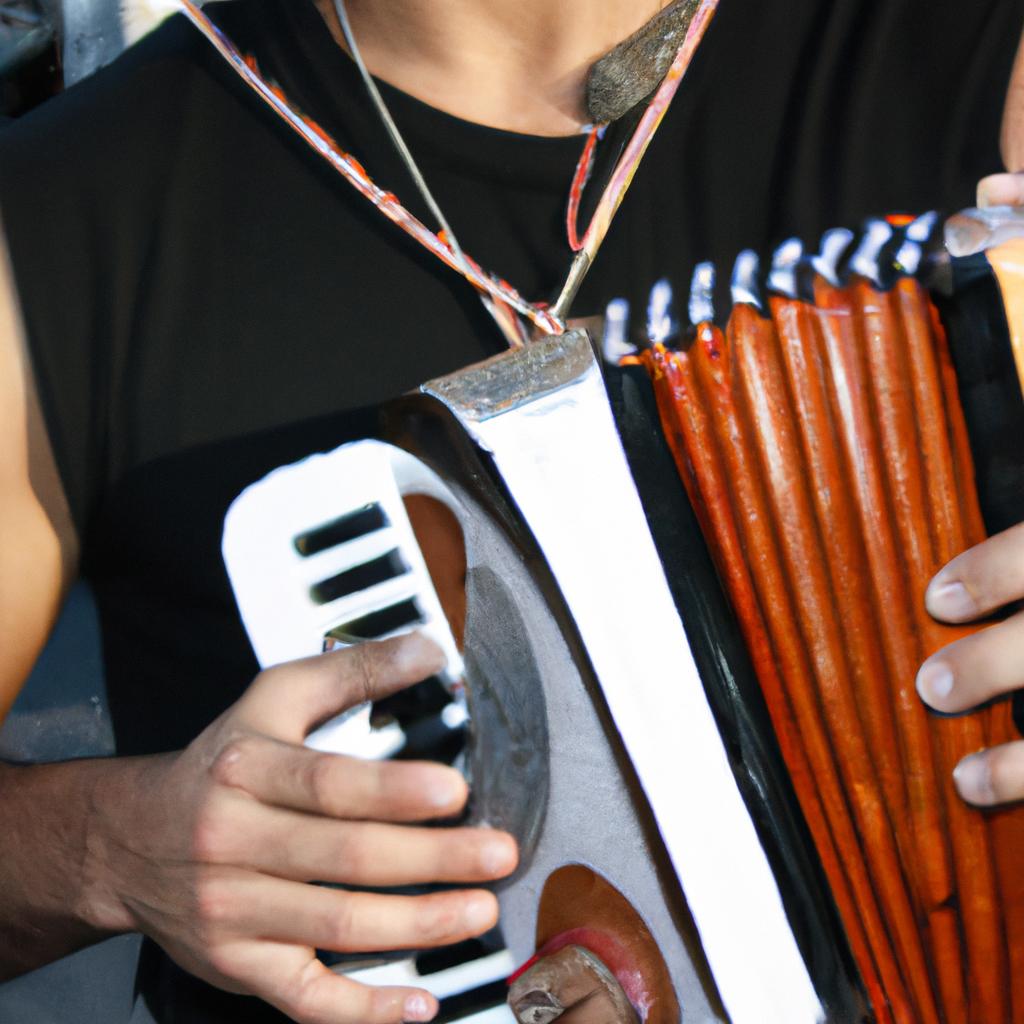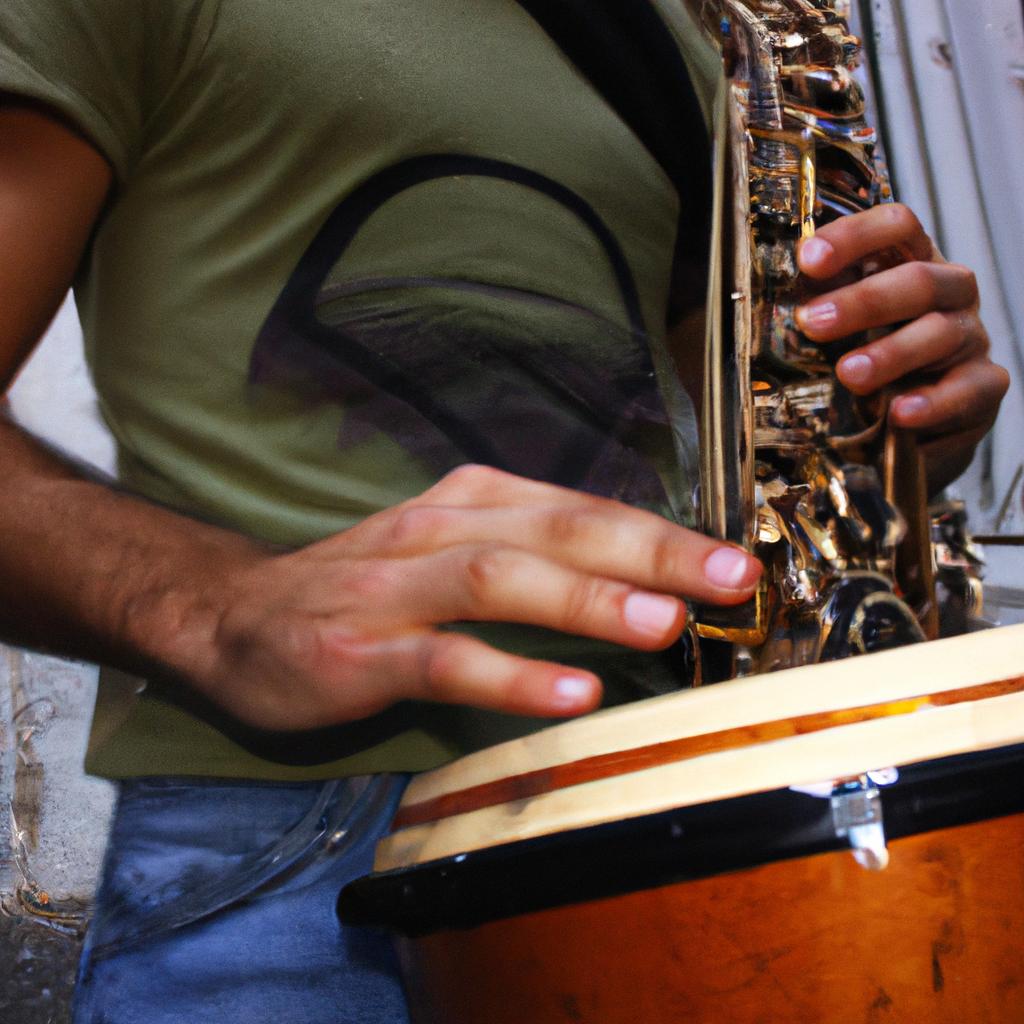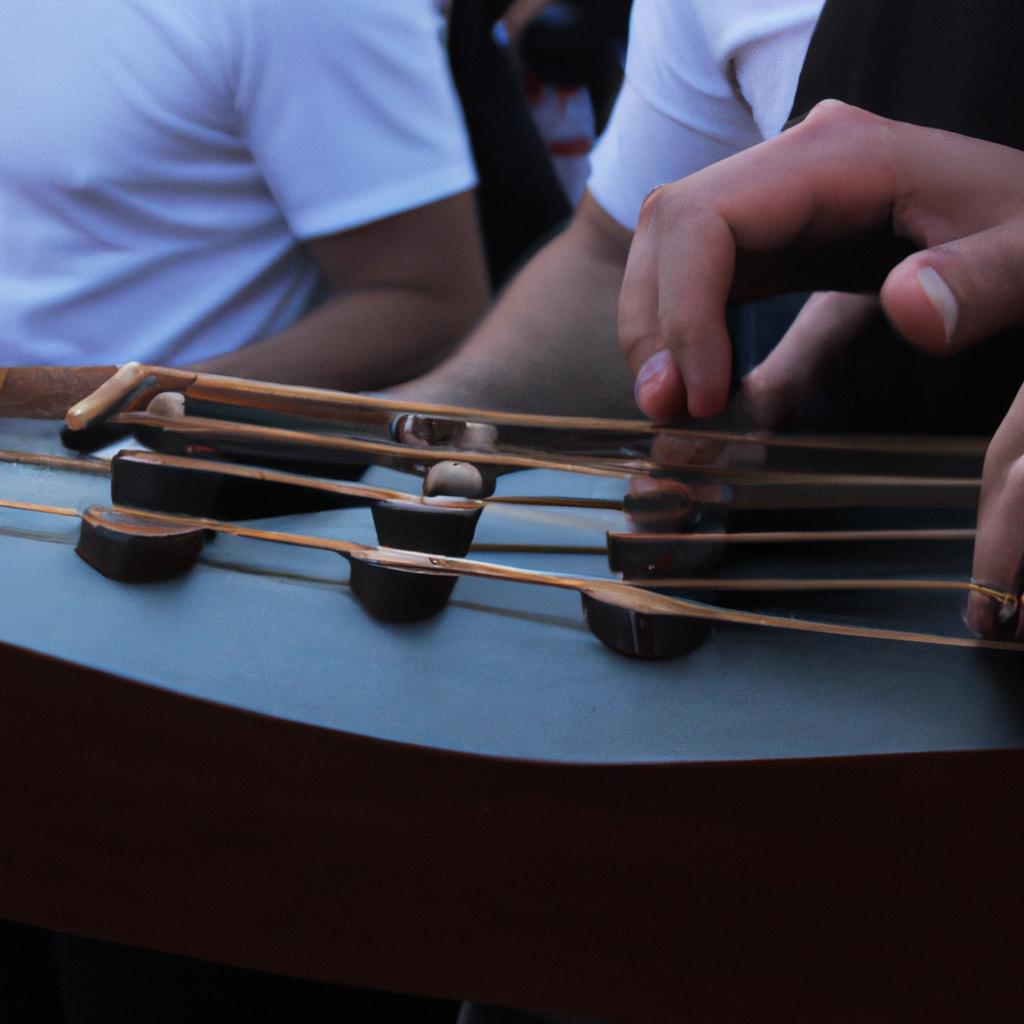Staccato, a musical technique characterized by short and distinct notes, has long been an essential element in the performance of tango music. In this article, we will delve into the intricacies of staccato in tango instrument technique, aiming to provide an informative overview for musicians and enthusiasts alike. By examining various aspects such as historical context, technical execution, and interpretive implications, we will shed light on the significance of staccato within the realm of tango music.
To illustrate the importance of mastering staccato in tango instrument technique, let us consider a hypothetical scenario involving a skilled bandoneon player. Imagine that this musician is performing with a renowned tango orchestra during a live concert. As the band starts playing a passionate tango piece, the bandoneon player’s ability to execute clean and precise staccato articulations becomes crucial in conveying the rhythmic energy and emotional depth inherent in the genre. This example highlights how staccato acts as a powerful tool for expressing both rhythmical nuances and intense emotions within tango music performances.
History of Staccato in Tango Music
To understand the significance and evolution of staccato technique in tango music, it is essential to delve into its historical roots. One prominent example showcasing the impact of staccato in this genre can be seen through the works of Eduardo Arolas, a renowned Argentine bandoneon player and composer from the early 20th century. Arolas demonstrated how skillful execution of staccato notes could enhance the rhythmic intensity and emotional depth within tango compositions.
The popularity and widespread adoption of staccato in tango music can be attributed to several factors:
- Expressive Intensity: The deliberate separation between individual notes achieved through staccato technique creates a sense of urgency and passion that resonates with both performers and listeners. This heightened expressiveness serves as an integral part of the storytelling aspect inherent in tango music.
- Rhythmic Drive: By emphasizing each note distinctly, staccato injects a pulsating energy into tango melodies, propelling them forward with irresistible momentum. This rhythmic drive not only adds dynamism but also encourages dancers to synchronize their movements with the music’s compelling beat.
- Contrasting Dynamics: Utilizing staccato alongside sustained legato notes allows for contrasting dynamics in tango pieces, creating moments of tension and release. The juxtaposition between short, detached sounds and longer, connected phrases enhances the overall musical narrative by highlighting different emotions or moods.
- Distinctive Artistic Identity: Staccato has become synonymous with tango music, distinguishing it from other genres such as classical or jazz. Its presence consistently characterizes traditional tangos while evolving over time to incorporate new styles and variations.
| Influence on Performers | Emotional Response |
|---|---|
| Exhilaration | Energetic |
| Passion | Sensual |
| Drama | Intense |
| Connection | Evocative |
In summary, the history of staccato in tango music showcases its profound impact on the genre’s development. The expressive intensity, rhythmic drive, contrasting dynamics, and distinctive artistic identity associated with this technique have contributed to tango’s enduring popularity worldwide. In the following section, we will delve into the characteristics that define staccato in tango instrument playing.
Moving forward, an exploration of the Characteristics of Staccato in Tango Instrument Playing reveals further insights into how this technique is employed by musicians within the context of tango music.
Characteristics of Staccato in Tango Instrument Playing
Having explored the rich history of staccato in tango music, we now turn our attention to the characteristics that define this unique technique when applied to various instruments. To illustrate these characteristics and engage readers further, let us consider a hypothetical scenario where an accomplished bandoneon player demonstrates the expressive power of staccato during a passionate tango performance.
Staccato, with its distinct short and detached notes, plays a vital role in shaping the rhythmic and melodic elements of tango music. When employed by different instruments such as the piano, violin, or guitar, it offers a range of sonic qualities that contribute to the overall intensity and emotion conveyed. Here are some key characteristics associated with staccato in tango instrument playing:
-
Articulation: The precise execution of each note is crucial in capturing the essence of staccato. Musicians emphasize clear beginnings and endings for each individual sound, creating sharp contrasts between sustained passages and punctuated phrases. This deliberate articulation allows for dynamic variations within a piece and enables performers to convey subtle nuances.
-
Rhythmical drive: Staccato injects energy into tango compositions through its rhythmic emphasis on strong beats. It serves as a driving force that propels the music forward, enhancing its lively nature and captivating listeners’ attention. By incorporating syncopated patterns or rapid-fire sequences of short notes, musicians create an infectious sense of urgency and momentum.
-
Emotional expression: Through careful manipulation of dynamics, timbre, and phrasing techniques specific to their respective instruments, musicians can evoke a wide spectrum of emotions using staccato in tango playing. Whether conveying joyous exuberance or melancholic longing, artists harness the power of abrupt breaks between notes to intensify emotional impact.
-
Interactive dialogue: In tango ensembles, staccato often fosters a musical conversation among the instruments. By interweaving short phrases and responding to one another’s accents and pauses, musicians establish an intricate dialogue that enhances the overall texture of the composition. This interaction adds depth and complexity to the music, creating a captivating experience for both performers and listeners alike.
Table: Emotional Response Elicited by Staccato in Tango Instrument Playing
| Emotion | Description | Example |
|---|---|---|
| Passion | Fiery and intense expression | A bandoneon player’s |
| vigorous staccato solo | ||
| Joy | Exuberant and upbeat energy | Violinist’s lively |
| staccato accompaniment | ||
| Longing | Melancholic longing and yearning | Guitarist’s heartfelt |
| staccato phrasing | ||
| Drama | Dramatic tension and suspenseful moments | Piano’s punctuated |
| staccato chords |
In conclusion, staccato in tango instrument playing encompasses various characteristics that contribute to its artistic impact. Through precise articulation, rhythmic drive, emotional expression, and interactive dialogue between instruments, this technique brings forth a wide range of emotions while maintaining the distinctive essence of tango music.
Transition into subsequent section:
Notable Tango Musicians Known for their Staccato Technique have further elevated the mastery of this technique through their exemplary performances and innovative approaches. Let us now delve into their contributions to better understand the lasting influence they have had on tango music.
Notable Tango Musicians Known for their Staccato Technique
Transitioning smoothly from the previous section on the characteristics of staccato in tango instrument playing, we now delve into a discussion of notable tango musicians known for their exceptional staccato technique. To illustrate the impact that mastering this technique can have on a performance, let us consider an example:
Imagine a skilled bandoneon player performing a passionate tango piece with precise and expressive staccato notes. The sharpness and clarity of each note punctuate the music, adding intensity to every phrase. This captivating display highlights the power and versatility of staccato in tango instrument playing.
- Staccato adds rhythmic drive: By articulating individual notes abruptly, it injects energy into the music, propelling dancers’ movements and engaging listeners.
- Emphasizes melodic accents: Staccato allows musicians to highlight specific beats or stresses within a melody, creating dynamics that evoke emotional responses.
- Provides contrast against legato passages: When juxtaposed with legato (smoothly connected) sections, staccato creates dynamic variation, heightening musical tension and release.
- Contributes to improvisation: Skilled tango musicians often use staccato as a tool for spontaneous expression during improvisational sections, infusing their performances with personal flair.
Now turning our attention to noteworthy figures renowned for their mastery of staccato technique in tango instrument playing, we present them in the following table:
| Musician | Instrument | Contributions |
|---|---|---|
| Astor Piazzolla | Bandoneon | Revolutionized traditional tango by incorporating jazz influences; famous for virtuosic play |
| Aníbal Troilo | Bandoneon | Known for his delicate yet powerful approach to staccato; a key figure in tango history |
| Osvaldo Pugliese | Piano | Noted for his rhythmic precision and ability to create dramatic contrasts |
| Eduardo Arolas | Guitar | Innovator who popularized the use of staccato on the guitar; influenced generations |
In conclusion, the skillful implementation of staccato technique by notable tango musicians has not only contributed to the richness and vibrancy of their performances but also shaped the development of tango music as an art form. By harnessing the power of staccato, these musicians have captivated audiences with their expressive playing styles, leaving lasting impressions that continue to inspire aspiring artists today.
Transitioning seamlessly into our next section about different approaches to incorporating staccato in tango music, we explore various methods employed by musicians seeking to infuse their compositions with this dynamic technique.
Different Approaches to Incorporating Staccato in Tango Music
Having examined the notable tango musicians known for their staccato technique, let us now delve into the various approaches used to incorporate staccato in tango music. To illustrate these different approaches, we will explore a hypothetical scenario involving a contemporary tango ensemble seeking to infuse staccato elements into their performance.
Imagine an ensemble comprised of skilled instrumentalists aiming to create a vibrant and energetic rendition of a classic tango composition. In order to achieve this desired effect, they employ diverse techniques to incorporate staccato passages throughout the piece. These include:
- Sharp articulation: The performers emphasize precise attacks on each note, heightening the rhythmic intensity and creating distinct separation between the notes.
- Dynamic contrasts: By alternating between softer legato sections and more forceful staccatos, the ensemble effectively adds texture and depth to their interpretation.
- Syncopation: Introducing unexpected accents within the musical phrases contributes to an unpredictable yet exhilarating experience for both musicians and listeners alike.
- Interplay with other instruments: Through careful coordination and synchronization with other members of the ensemble, certain instruments may punctuate specific moments with well-placed staccato embellishments, enhancing overall cohesion and impact.
- Evokes feelings of passion and urgency
- Enhances rhythmic complexity
- Adds excitement and dynamism
- Provides opportunities for individual expression
Additionally, let us examine a table showcasing some key characteristics associated with different approaches to incorporating staccato:
| Approach | Description | Example |
|---|---|---|
| Accented Stabs | Short bursts of intense sound created by abrupt stops | A violinist forcefully plucking strings |
| Chopping Technique | Quick, rhythmic articulation resembling the chopping of wood | A pianist rapidly striking keys |
| Pulsating Rhythms | Repeated, punctuated notes creating a pulsing effect | A bandoneon player emphasizing downbeats |
| Staccato Cascades | Rapid sequences of staccato notes flowing in an arpeggiated manner | A guitarist playing cascading chord patterns |
Incorporating these diverse approaches to staccato allows musicians to infuse their tango performances with a wide range of emotions and sonic textures. By employing sharp articulation, dynamic contrasts, syncopation, and interplay with other instruments, they can create an engaging musical experience that captivates audiences.
Understanding the impact of staccato on tango music dynamics will shed further light on the profound influence this technique has had on the evolution of this genre.
Impact of Staccato on Tango Music Dynamics
Staccato in Tango Instrument Technique: An Informative Overview
Having explored the various approaches used by musicians to incorporate staccato in tango music, it is now important to delve into the impact that this technique has on the dynamics of the genre. By examining its effects on rhythm, emotion, and overall musicality, we can gain a deeper understanding of how staccato contributes to the unique character of tango compositions.
Impact of Staccato on Tango Music Dynamics:
To illustrate the significance of staccato in tango music dynamics, let us consider an example where a bandoneón player incorporates this technique during a passionate performance. As the musician skillfully executes short and distinct notes with precise articulation, a sense of urgency and intensity permeates through the composition. This heightened expression captivates both performers and listeners alike, creating an emotional connection between them.
The following bullet point list highlights some key aspects influenced by staccato in tango instrument playing:
- Rhythmic drive: Staccato adds an energetic pulse to tango music, propelling dancers’ movements and infusing vitality into every beat.
- Emotional depth: The sharpness and sudden breaks created by staccato evoke contrasting emotions within a piece, ranging from melancholy to exuberance.
- Artistic tension: The use of staccato creates moments of suspense and anticipation as notes are played abruptly or unexpectedly paused.
- Musical interplay: When multiple instruments employ staccato simultaneously or respond to each other’s phrases using this technique, it enhances dialogue-like exchanges within ensembles.
| Aspects Influenced by Staccato | Impact |
|---|---|
| Rhythmic drive | Energetic pulse |
| Emotional depth | Contrasting emotions |
| Artistic tension | Suspense and anticipation |
| Musical interplay | Dialogue-like exchanges |
As we have examined the impact of staccato on tango music dynamics, it becomes evident that this technique plays a crucial role in shaping the overall experience for both performers and listeners. Building upon this understanding, the subsequent section will explore the artistic expressiveness associated with staccato in tango instrument playing, shedding light on its ability to evoke a range of emotions and create captivating musical narratives.
Exploring the Artistic Expressiveness of Staccato in Tango Instrument Playing
The impact of staccato technique in tango music cannot be understated. This section delves into the various ways in which staccato influences the dynamics and overall character of tango instrument playing.
Staccato, characterized by short and detached notes, adds a distinct rhythmic quality to tango music. By employing this technique, musicians are able to create contrasting accents and punctuations within their melodies. For instance, imagine a violinist passionately performing a tango piece with alternating legato and staccato passages. The sudden shift from smooth legato notes to crisp staccato articulations creates an expressive tension that captivates the listener’s attention.
To further understand the impact of staccato in tango instrument playing, let us explore its effects through different aspects:
- Rhythm: Staccato contributes to the syncopated rhythms commonly found in tango music. It accentuates specific beats or off-beats, enhancing the pulsating energy inherent in this genre.
- Articulation: The use of staccato allows instrumentalists to articulate each note more precisely and distinctly. This clarity heightens the emotional intensity conveyed through the music.
- Phrasing: Incorporating staccato within phrases helps shape musical ideas and emphasizes certain melodic motifs or themes.
- Dynamic Contrast: Staccato contrasts with sustained legato passages, creating dynamic variations that contribute to the ebb and flow of emotions throughout a tango composition.
In examining these aspects, it becomes evident that staccato plays a vital role in shaping the artistic expressiveness of tango instrument playing. Its ability to evoke feelings such as passion, drama, excitement, or melancholy enhances the emotional connection between performers and audiences alike.
| Aspect | Description |
|---|---|
| Rhythm | Accentuates beats or offbeats, contributing to the syncopated rhythms of tango music. |
| Articulation | Enhances precision and distinctness of each note played, intensifying emotional expression in tango instrument playing. |
| Phrasing | Helps shape musical ideas, emphasizing melodic motifs or themes within a tango composition. |
| Dynamic Contrast | Provides contrasting elements between staccato passages and sustained legato sections, creating dynamic variations that heighten the emotional impact of the music. |
By harnessing the power of staccato technique, instrumentalists are able to elevate their performances and convey the rich emotions inherent in tango music. The interplay between rhythm, articulation, phrasing, and dynamic contrast allows musicians to create compelling narratives through their instruments. Through this exploration, we gain insight into how staccato influences the dynamics and artistic expressiveness of tango instrument playing, ultimately enriching our understanding and appreciation of this captivating genre.




